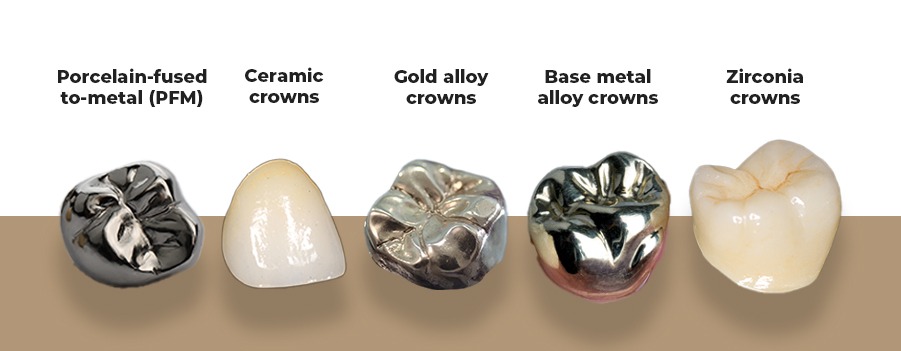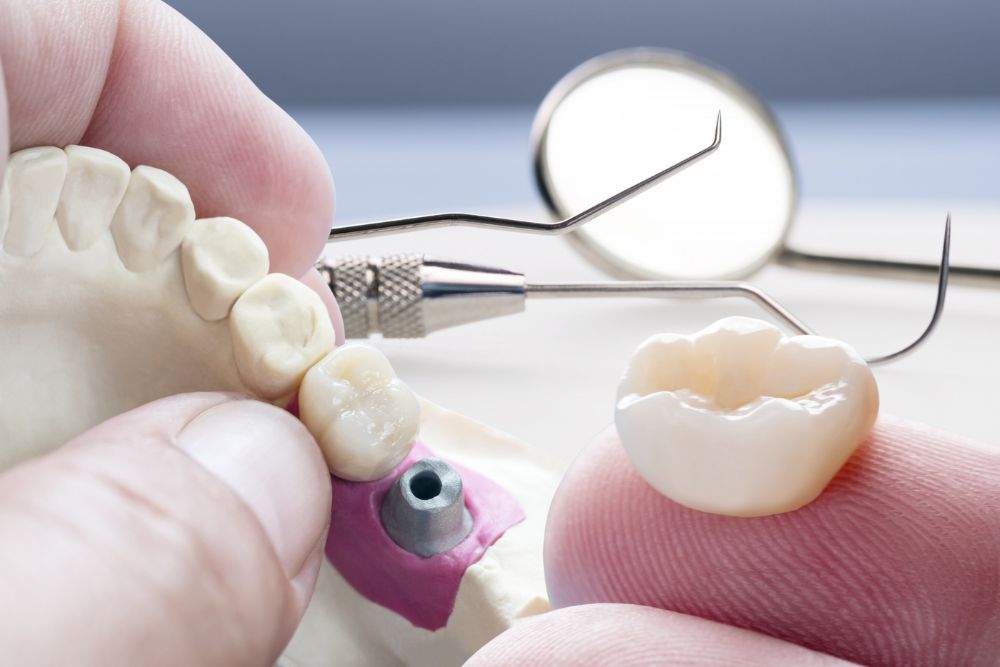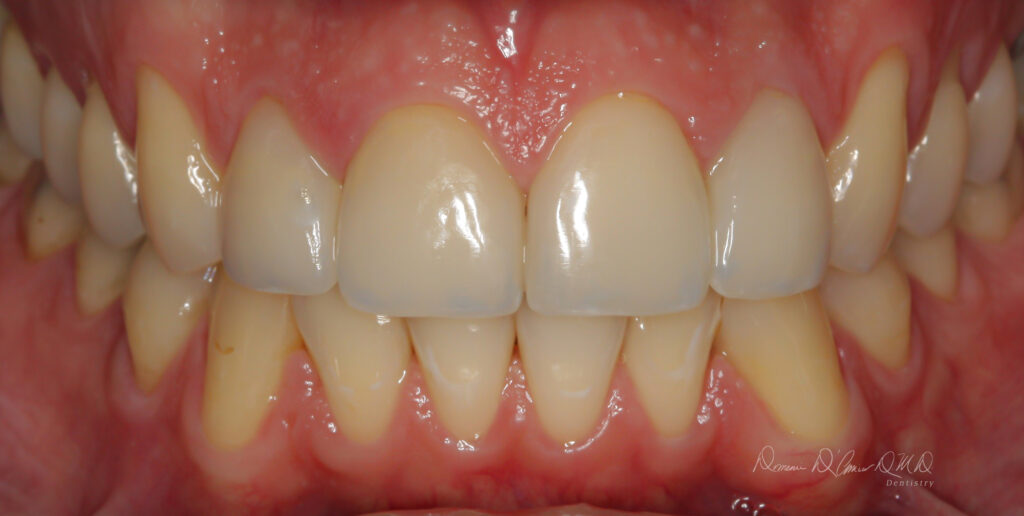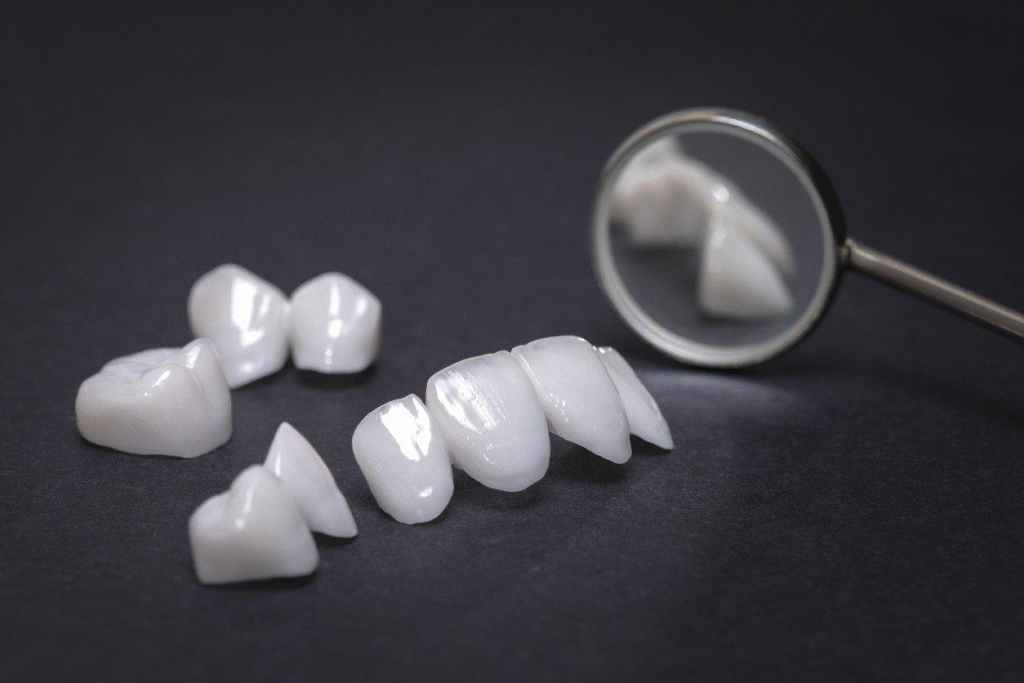
In restorative dentistry, dental crowns stand as one of the most effective solutions for repairing damaged teeth. These tooth-shaped caps not only protect weakened teeth but also fully restore their appearance and function. From fixing broken or decayed teeth to enhancing smile aesthetics, dental crowns have wide-ranging applications in modern dentistry.
Today’s types of dental crowns include various materials, such as ceramic, metal, zirconia, gold, and porcelain-fused-to-metal (PFM), each offering unique benefits. The ideal choice depends on multiple factors, including tooth location, aesthetic needs, required durability, and the patient’s budget. This comprehensive guide explores all crown varieties, their specific uses, and how to select the best option.
Understanding these differences in dental crown types helps you make informed decisions with your dentist about your oral health and smile, as we outline the advantages, limitations, and selection criteria for each crown type, enabling you to achieve optimal results.
What Are Dental Crowns?
A dental crown, also known as a “tooth cap,” is a fixed prosthesis that completely covers the visible part of a tooth. This treatment is recommended when a tooth is severely damaged but still has a healthy, preservable root. Crowns are primarily made from various materials, including all-ceramic, noble metals (like gold), or a combination of ceramic and metal (PFM).
At our Watertown and Wayland practices, D’Amico Dental Care provides expert crown treatments for multiple dental needs: protect weakened teeth following root canal treatment, restore broken or worn-down teeth, cover teeth with large fillings, improve both the function and appearance of damaged teeth, and serve as anchors for dental bridges.
Types of dental crowns – The installation process involves:
- Trimming and preparing the tooth (removing 1.5–2 mm from each side)
- Taking an accurate impression of the prepared tooth
- Crafting the crown in a specialized lab (2–3 weeks)
- Fitting a temporary trial crown
- Final adjustments and cementing the permanent crown

Why Are Dental Crowns Used?
Dental crown types are a widely used restorative solution recommended for many situations:
- Protecting Weakened Teeth:
- After root canal treatment (when teeth become brittle)
- Teeth with extensive decay that can’t be fixed with regular fillings
- Preventing fractures in teeth with thin walls
- Restoring Tooth Function:
- Repairing broken or worn-down teeth
- Restoring natural chewing ability
- Replacing missing teeth as bridge supports
- Enhancing Aesthetics:
- Covering severely discolored teeth
- Correcting irregular tooth shapes/sizes
- Creating a uniform smile line
- Special Applications:
- Covering dental implants
- Protecting children’s teeth with weak enamel
- Restoring teeth with congenital defects
Crowns are advised when over 50% of the tooth structure is lost. Types of dental crowns vary, but all fully encase the tooth to restore both function and appearance.

Porcelain Dental Crowns
All-ceramic crowns are considered an ideal choice for restoring front teeth due to their unique qualities. With their transparency and light reflection similar to natural tooth enamel, they deliver the most aesthetically beautiful results. Among their main uses are restoring front teeth, treating cases of metal allergies, and creating Hollywood smiles. Since they contain no metal in their structure, these crowns have excellent tissue compatibility with gums and minimize gum irritation.
While all-ceramic crowns can also be used for back teeth, they’re typically preferred for front teeth because they’re less durable than metal-ceramic crowns. With proper care, these crowns can last 10-15 years, though they do require more tooth reduction and come at a higher cost. Types of dental crowns vary, but it’s important to note that all-ceramic crowns remain the top choice for patients seeking completely natural-looking results.

Ceramic Dental Crowns
Modern ceramic crowns, especially those made from zirconia and lithium disilicate, have revolutionized restorative dentistry. With their enamel-like transparency and optical properties, they deliver the most natural-looking aesthetic results. Their most important applications include restoring front teeth where aesthetics are a priority, cases of metal allergies, and creating Hollywood smiles. Types of dental crowns vary, but zirconia crowns are also suitable for back teeth due to their exceptional strength.
These dental crown types offer excellent benefits like superior tissue compatibility (reducing gum inflammation), low thermal conductivity (decreasing tooth sensitivity), and high wear resistance, making them an ideal choice. However, they do require more tooth preparation than veneers and come at a higher cost. With proper care, they typically last 10 to 15 years, making them the best option for patients seeking natural-looking, long-lasting results. The choice between different ceramic types (zirconia or lithium disilicate) should be based on the tooth’s position and your dentist’s recommendation.

Metal Dental Crowns
Metal crowns, primarily made from gold alloys, nickel, or chromium-cobalt, are known as the most durable type of crowns. These crowns are mainly used for back teeth that endure heavy chewing forces. Their biggest advantage is exceptional strength and fracture resistance, making them ideal for patients who grind their teeth or exert strong chewing pressure.
Key Features and Applications:
- Extremely long lifespan (often over 20 years)
- Require less tooth preparation than ceramic crowns
- High resistance to wear and pressure
- Perfect for molars exposed to strong forces
- Typically more affordable than all-ceramic crowns
Drawbacks and Limitations:
When considering types of dental crowns, it’s important to note that the metallic appearance makes them unsuitable for front teeth, while some patients may also develop metal allergies, though nowadays they’re often used as the base for PFM (porcelain-fused-to-metal) crowns, which combine metal’s strength with ceramic’s aesthetic appeal.

Porcelain-Fused-to-Metal (PFM) Crowns
PFM (Porcelain-Fused-to-Metal) crowns, also known as metal-ceramic crowns, are among the most widely used types of dental crowns in restorative dentistry. At our Watertown and Wayland practices, D’Amico Dental Care specializes in high-quality PFM crowns that deliver both strength and aesthetics. These crowns combine a metal core (typically gold alloys or nickel-chromium) with a ceramic outer layer. The metal core provides exceptional strength and durability, while the porcelain layer creates a natural, attractive appearance.
“ PFM crowns have good mechanical properties, satisfactory esthetic results, and an acceptable biological quality needed for periodontal health. “
Key Advantages:
- High strength (ideal for back teeth)
- Good aesthetics (especially for front teeth)
- Long lifespan (15-20 years with proper care)
- Relatively affordable compared to all-ceramic crowns
- Excellent marginal fit with the tooth
Drawbacks and Limitations:
- Possible dark metal line visibility at gum margins if recession occurs
- Require more tooth preparation than all-metal crowns
- The porcelain layer may chip under extreme pressure
- Potential metal allergies in some patients
These crowns are an excellent choice for patients seeking the perfect balance between strength, durability, and aesthetics.

Zirconia Dental Crowns
Zirconia crowns represent the new generation of dental restorations, offering an unbeatable combination of strength and beauty. Made from zirconium oxide – an exceptionally fracture-resistant material – these crowns work well for both front and back teeth, providing natural aesthetics while withstanding heavy chewing forces. When considering types of dental crowns, zirconia stands out for its versatility.
Key advantages of zirconia crowns:
- Exceptional strength (over 900 MPa)
- Beautiful, natural-looking transparency
- Excellent tissue compatibility (reduced gum irritation)
- Superior wear and corrosion resistance
- No metal layer (eliminates dark gum lines)
- Long lifespan (15-20 years with proper care)
Important considerations:
- Higher cost compared to PFM crowns
- Requires specialized equipment and expertise
- Slightly more tooth reduction than metal crowns
- Ideal for patients with metal allergies
Zirconia crowns are currently considered the gold standard in aesthetic-restorative dentistry.

Gold Dental Crowns
Golden crowns are made from dental gold alloys, typically containing 60-75% gold along with other metals like platinum and palladium. These crowns continue to have a place in modern dentistry due to their unique advantages. Among the different types of dental crowns, gold crowns are primarily used for back teeth, where strength and durability are top priorities.
Key benefits of gold crowns:
- Exceptional durability: Lasts 20-30+ years with proper care
- Excellent tissue compatibility: Minimal gum irritation
- Less tooth reduction: Preserves more healthy tooth structure
- Precise marginal fit: Reduces the risk of secondary decay
- Wear-resistant: Won’t damage opposing teeth
Drawbacks and limitations of these dental crown types:
- Metallic appearance (not suitable for front teeth)
- Higher cost due to precious metals
- Possible metal allergies in some patients
- Requires highly skilled dentists for proper fabrication
How to Choose the Right Dental Crown for You
Choosing the right dental crown depends on several factors that should be evaluated by your dentist. Among the different types of dental crowns, the most important criteria include the tooth’s position (front or back), extent of tooth damage, aesthetic considerations, budget, and special health conditions like metal allergies. For front teeth where appearance is key, all-ceramic or zirconia crowns are ideal. For back teeth that endure heavy chewing forces, metal or PFM crowns may be more suitable.
Key considerations when selecting crowns:
- Aesthetics: All-ceramic & zirconia for front teeth
- Strength: Metal & PFM for molars
- Sensitivity: Metal-free options for those with allergies
- Cost: PFM crowns offer good value
- Longevity: Gold and zirconia crowns last the longest
For optimal results, we recommend consulting with our experienced prosthodontists at D’Amico Dental Care. Serving Watertown and Wayland, our specialists perform comprehensive evaluations considering these factors. Your gum health and neighboring teeth also play important roles in this decision.
| Crown Type | Best For | Pros | Cons | Longevity |
| Porcelain (Feldspathic) | • Front teeth • Aesthetic zones | • Most natural translucency • Excellent color matching | • Brittle (prone to chipping) • High wear against natural teeth | 10-15 years |
| All-Ceramic (e.max) | • Anterior/posterior teeth • Metal allergy cases | • Stronger than feldspathic • Good aesthetics | • Requires more tooth reduction • Not for heavy bruxers | 15-20 years |
| Full Metal (Gold Alloy) | • Molars (high-stress areas) • Minimal space cases | • Extremely durable • Minimal tooth removal • Kind to opposing teeth | • Poor aesthetics • Thermal sensitivity | 25+ years |
| Porcelain-Fused-to-Metal (PFM) | • Budget-friendly option • Posterior teeth | • Combines strength & aesthetics • Proven technology | • Dark gum line visible • Porcelain may chip | 15-20 years |
| Zirconia | • Posterior teeth • Bruxism patients | • Highest strength (900-1,200 MPa) • Minimal wear | • Less natural translucency • Difficult adjustments | 20+ years |
| Gold-Plated Zirconia | • High-end posterior restorations | • Combines zirconia strength with gold aesthetics | • Highest cost • Requires an expert technician | 25+ years |
FAQ
1. What are the characteristics of all-porcelain crowns?
All-porcelain crowns are made of dental ceramic and provide the most natural appearance. These crowns are mostly used for front teeth because they offer excellent translucency and color-matching capabilities. They have good resistance to wear but may not be suitable for posterior teeth, which endure greater pressure. These crowns are fully biocompatible and do not cause sensitivity.
2. What are the advantages of all-ceramic crowns?
All-ceramic crowns are the latest generation of dental crowns, combining strength and aesthetics. They are made from advanced ceramic materials such as aluminum oxide or zirconia. Compared to traditional porcelain crowns, they offer greater durability and are suitable for both front and back teeth. These crowns are perfectly matched to the color of your natural teeth.
3. When are metal crowns used?
Metal crowns are typically made from gold alloys, platinum, or base metals like nickel and chromium. These crowns offer the highest durability and strength, making them ideal for molars that endure heavy chewing forces. Their biggest drawback is their metallic appearance, which makes them unsuitable for front teeth. They cause minimal wear on opposing teeth and have an exceptionally long lifespan.
4. What are PFM crowns like?
Porcelain-fused-to-metal crowns combine the strength of metal with the aesthetics of porcelain. They consist of a metal core covered with a layer of porcelain. Their advantages include high durability and relatively reasonable cost. However, over time, the metal margin near the gum line may become visible, and it may cause gum sensitivity in some individuals.
5. Why are zirconia crowns popular?
Zirconia crowns are made from the latest dental materials, offering both the strength of metal and the aesthetics of ceramic. They are a great option for people with metal allergies. Zirconia is highly durable and has a very low risk of cracking. Due to their high rigidity, they are also suitable for patients who grind their teeth.
6. What are gold crowns used for?
Gold crowns are made from gold alloys, which are highly biocompatible. They are primarily used for molars that are not visible. Gold is softer than other metals, causing less wear on opposing teeth. These crowns are the most expensive type of metal crowns but have an extremely long lifespan, sometimes lasting up to 30 years.
7. How do we select the right type of crown?
The choice of crown depends on various factors: the tooth’s position in the mouth, the amount of pressure it endures, aesthetic requirements, and budget. Your dentist will consider these factors and recommend the best option. For front teeth, all-ceramic or zirconia crowns are usually recommended, while for posterior teeth, metal or PFM crowns may be more suitable.
8. How do we care for dental crowns?
All types of dental crowns require proper care and maintenance. Maintaining oral hygiene, including brushing twice daily and flossing, is essential. Avoiding hard foods like ice or hard candies helps prolong the crown’s lifespan. Regular dental check-ups every six months are recommended to monitor the crown’s condition and the health of surrounding teeth.

